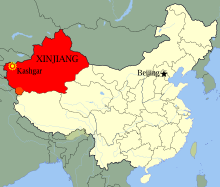
East Turkestan is a loosely-defined geographical and historical region in the western provinces of the People's Republic of China, which varies in meaning by context and usage. The term was coined in the 19th century by Russian Turkologists, including Nikita Bichurin, who intended the name to replace the common Western term for the region, Chinese Turkestan, which referred to the Tarim Basin in the southwestern part of Xinjiang during the Qing dynasty. The medieval Persian toponym "Turkestan" and its derivatives were used by the local population as early as the 7th century. Historical manuscripts, dating back to the 7th and 9th century, found in the Turpan and Khotan regions, show that the name Turkestan was used to describe the region. The opening of the 11th century literary work Kutadgu Bilig by Kara-Khanid statesman Yusuf Khass Hajib also describes the region as Turkestan. Beginning in the 17th century, Altishahr, which means "Six Cities" in Uyghur, became the Uyghur name for the Tarim Basin. Uyghurs also called the Tarim Basin "Yettishar," which means "Seven Cities," and even "Sekkizshahr", which means "Eight Cities" in Uyghur. Chinese dynasties from the Han dynasty to the Tang dynasty had called an overlapping area the "Western Regions". The parts of this area conquered by the Manchu Qing Dynasty were termed "Xinjiang" from the 18th century on.
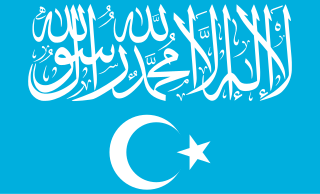
The Turkistan Islamic Party (TIP) which has often been confused as the East Turkestan Islamic Movement (ETIM) and other names, is a Uyghur Islamic extremist organization founded in Pakistan by Hasan Mahsum. Its stated goals are to establish an Islamic state in Xinjiang and Central Asia, and eventually a Caliphate. The United States removed the "East Turkistan Islamic Movement (ETIM)," which had been confused as the "East Turkistan Islamic Party / Turkistan Islamic Party," from its list of Terrorist Organizations in 2020, claiming it ceased to exist. However, the U.S. State Department later stated that "ETIM was removed from the list because, for more than a decade, there has been no credible evidence that ETIM continues to exist as the same organization that was conducting terrorist attacks in Syria at the time of their designation." The U.S. State Department further stated that "Uyghur terrorists fighting in Syria and Afghanistan are members of the Turkistan Islamic Party (TIP)"and that the TIP is "a separate organization that China and others have incorrectly identified as ETIM."

The East Turkestan Liberation Organization (ETLO) was a secessionist Uyghur organization that advocated for an independent Uyghur state named East Turkestan in the Western Chinese province known as Xinjiang. The organization was established in Turkey in 1990 or 1996 to fight against the Chinese government in Xinjiang, a territory of ethnic Uyghur majority. ETLO is a designated terrorist organization by the governments of China, Kazakhstan, and Kyrgyzstan.
Hasan Mahsum, also known as Abu-Muhammad al-Turkestani and Ashan Sumut, was the leader of the Islamic extremist group Turkistan Islamic Party and suspected of having ties with Al Qaeda. He was shot dead in a counter-terrorism operation on October 2, 2003 by the Pakistani Army.

The January 2007 Xinjiang raid was carried out on January 5, 2007, by Chinese paramilitary police against a suspected East Turkestan Islamic Movement (ETIM) training camp in Akto County in the Pamir plateau.
Terrorism in China refers to the use or threatened use of violence to effect political or ideological change in the People's Republic of China. The definition of terrorism differs among scholars, between international and national bodies and across time and there is no legally binding definition internationally. In the cultural setting of China, the term is relatively new and ambiguous.
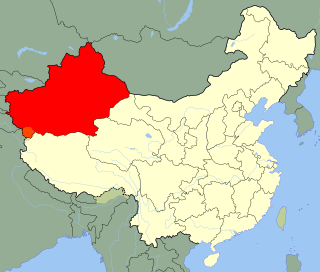
The 2008 Uyghur unrest is a loose name for incidents of communal violence by Uyghur people in Hotan and Qaraqash county of Western China, with incidents in March, April, and August 2008. The protests were spurred by the death in police custody of Mutallip Hajim.

The 2008 Kashgar attack occurred on the morning of 4 August 2008, in the city of Kashgar in the Western Chinese province of Xinjiang. According to Chinese government sources, it was a terrorist attack perpetrated by two men with suspected ties to the Uyghur separatist movement. The men reportedly drove a truck into a group of approximately 70 jogging police officers, and proceeded to attack them with grenades and machetes, resulting in the death of sixteen officers.
Abdul Haq al-Turkistani is a Uyghur Islamic militant who leads the Turkistan Islamic Party. The United States Treasury reported he took over leadership of the organization in 2003, following the death of its previous leader, and took a seat on al-Qaeda's shura in 2005.
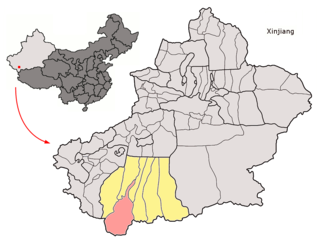
The 2011 Hotan attack was a bomb-and-knife attack that occurred in Hotan, Xinjiang, China on 18 July 2011. According to witnesses, the assailants were a group of 18 young Uyghur men who opposed the local government's campaign against the burqa, which had grown popular among older Hotan women in 2009 but were also used in a series of violent crimes. The men occupied a police station on Nuerbage Street at noon, killing two security guards with knives and bombs and taking eight hostages. The attackers then yelled religious slogans, including ones associated with Jihadism, as they replaced the Chinese flag on top of a police station with another flag, the identity of which is disputed.
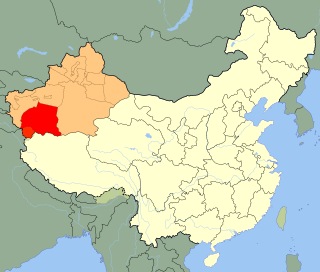
The Pishan hostage crisis occurred on the night of December 28, 2011, in Koxtag, Pishan/Guma County, Hotan Prefecture, Xinjiang Uygur Autonomous Region, China. A group of 15 Uyghur youths kidnapped two goat shepherds for directions. They were soon confronted by a group of five Pishan policemen, who tried to negotiate for the shepherds' release. The group attacked the policemen with knives, killing one and injuring another. The police shot back, killing seven hostage-takers, wounding and capturing four, freeing the two shepherds. The Xinjiang government called the kidnappers "violent terrorists", while a Uyghur exile group claimed the kidnappers' actions were the result of "police repression".

Abdul Shakoor al-Turkistani, also known as Abdul Shakoor Damla and Emeti Yakuf Uyghur: ئەخمەت ياقۇپ, Exmet Yaqup, was the emir of the East Turkistan Islamic Party, an Islamist organisation that seeks independence for China's Xinjiang province and for it to become an Islamic state. In August 2011, Abdul Shakoor reportedly appeared in a video with his face obscured taking responsibility for the 2011 Kashgar attacks and 2011 Hotan attack.

Tianjin Airlines Flight 7554 was a scheduled passenger flight between Hotan and Ürümqi in China's Xinjiang Autonomous Region. The aircraft operating this route on 29 June 2012, an Embraer 190, took off from Hotan at 12:25 pm; within ten minutes, six ethnic Uyghur men, one of whom allegedly professed his motivation as jihad, announced their intent to hijack the aircraft, according to multiple witnesses. In response, passengers and crew resisted and successfully restrained the hijackers, who were armed with aluminium crutches and explosives.
The 2012 Yecheng attack was a terrorist attack by Uyghur separatist extremists that occurred on February 28, 2012, in Yecheng, Xinjiang, a remote town situated about 150 miles from China's border with Pakistan. Details of the attack are disputed: according to Chinese government reports and court documents, at around 6 p.m. that day, a group of eight Uyghur men led by religious extremist Abudukeremu Mamuti attacked pedestrians with axes and knives on Happiness Road. Local police fought with the attackers, ultimately killing all and capturing Mamuti. State-run media reported that one police officer died and four police were injured, while 15 pedestrians died from Mamuti's assault and 14 more civilians were injured. Chinese officials characterized the event as a "terrorist attack."
On 24 April 2013, ethnic clashes occurred in Marelbeshi (Bachu), Xinjiang, China. The violence left at least 21 people dead, including 15 police and officials.
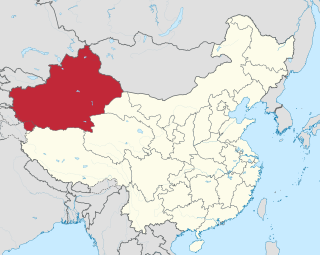
The Xinjiang conflict, also known as the East Turkistan conflict, Uyghur–Chinese conflict or Sino-East Turkistan conflict, is an ongoing ethnic geopolitical conflict in what is now China's far-northwest autonomous region of Xinjiang also known as East Turkistan. It is centred around the Uyghurs, a Turkic ethnic group who constitute a plurality of the region's population.
On 26 June 2013, rioting broke out in Shanshan County, in the autonomous region of Xinjiang, China. 35 people died in the riots, including 22 civilians, two police officers and eleven attackers.
On 28 October 2013, a car ran over pedestrians and crashed in Tiananmen Square, Beijing, China, in a terrorist suicide attack. Five people died in the incident; three inside the vehicle and two others nearby. Police identified the driver as Usmen Hasan and the two passengers as his wife, Gulkiz Gini, and his mother, Kuwanhan Reyim. An additional 38 people were injured.

On 30 April 2014, a bomb-and-knife attack occurred in the Chinese city of Ürümqi, Xinjiang. The terrorist attack killed 3 people, and injured 79 others. The attack coincided with the conclusion of a visit by Xi Jinping, General Secretary of the Chinese Communist Party to the region.
On the early morning of Wednesday, 30 July 2014, Juma Tahir, the imam of China's largest mosque, the Id Kah Mosque in northwestern Kashgar, was stabbed to death by three young male Uyghur extremists. Religious leaders across denominations condemned the attack.
